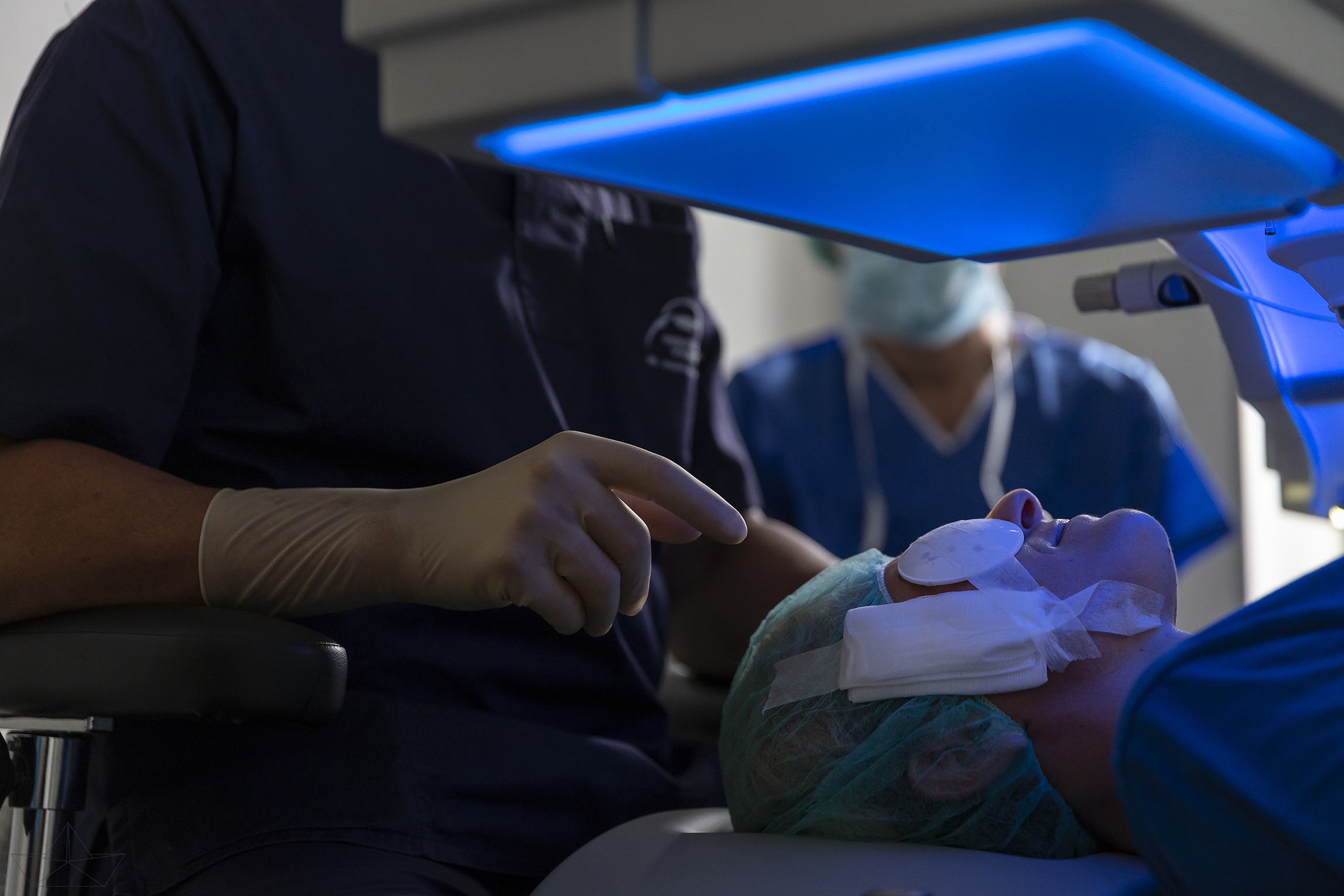
FemtoLASIK
The most effective and advanced tailor-made laser eye surgery procedure for the treatment of your vision problem. The great innovation of FemtoLASIK is the blade-free creation of the corneal flap with much lower risk of postoperative aberrations and irregular astigmatism.
FemtoLasik is one of the most effective and advanced computer-controlled technologies in the refractive surgery field. When performing it, the surgeon uses two types of lasers (Femtolaser and Excimer laser). The term LASIK stands for laser in-situ keratomileusis while Femto refers to the technology used, i.e. the innovative Femtolaser. This femtosecond laser emits ultra-short pulses, applying millions of tiny laser spots in a row, one hundredth of a millimetre wide, to create a small flap in the cornea and prepare its surface for the next step, the vision correction through Excimer laser.
What makes FemtoLasik truly innovative is that it is a completely blade-free procedure. The previous laser techniques (LASIK) used mechanical tools like the microkeratome blade, which could make irregular flaps or incomplete cuts, thus leading to potential post-surgery complications and irregular astigmatism.
The high precision and safety of the FemtoLASIK method allow the surgeon to tailor the procedure according to the characteristics and vision problem of each individual patient.
XTRA: The Advantage in Refractive Surgery
The new XTRA procedure allows FemtoLASIK to be safely performed on patients with borderline corneal features, such as thin corneas or corneal irregularities. It also offers a solution for cases where high ablation levels are required, leaving residual corneal thickness within the limits specified by treatment nomograms.
The purpose of this parasurgical therapy, also known as ‘corneal photodynamic treatment’, is to enhance the connections between corneal fibers and increase their strength. This reduces the risk of corneal weakening over time and improves long-term refractive stability.
The XTRA procedure involves two main steps:
- during the first phase, the cornea is saturated with Riboflavin eye drops (Vitamin B2) for approximately 10 minutes per eye
- the second phase involves exposing the corneal tissue to low-dose ultraviolet A (UVA) light for another 10 minutes. The combined action of Vitamin B2 and UVA rays increases the molecular cross-links that strengthen the innermost layers of the cornea, making it stiffer and less susceptible to degradation
The Femto Lasik technique
The FemtoLASIK laser technique is recommended for the correction of myopia up to 7-8 dioptres, astigmatism up to 5 dioptres and hyperopia up to 4-5 dioptres depending on the thickness and curvature of the cornea.
Dr. Angelo Appiotti, with over 30 years of experience, uses state-of-the-art techniques in the laser and surgical treatment of vision problems in patients and professional athletes, and is an authority in the field of refractive surgery in Europe.
With more than 30,000 eyes treated, he is one of the most renowned surgeons specialising in the FemtoLasik technique.
The five steps of the FemtoLASIK technique
Once anesthetic drops have been administered and an eyelid retractor (blepharostat) has been put in place, the patient is positioned for surgery. The femtosecond laser creates a flap in 9-10 seconds
The patient is positioned under the excimer laser
The flap is lifted and folded back, exposing the corneal stroma underneath
The excimer laser ablates the corneal tissue according to the desired refraction
At the end of the surgery, antibiotic-cortisonic drops are put in
The flap is laid back into place
The Best Candidate
- people between 18 and 60
- good state of health
- myopia up to -7/-8 dioptres, astigmatism up to 4-5 dioptres and hyperopia up to 4-5 dioptres
- stable prescription for the last 12 months
- no previous eye diseases, such as herpes, diabetes mellitus and diseases treated with cortisone
- non-pregnant
The Benefits of FemtoLASIK
- excellent refraction results
- fast recovery
- no post-surgery pain or discomfort
- no corneal opacity
- a more stable result over the years
- reduction in retreatment rates
Visual recovery
Visual recovery may take 12-24 hours: recovering from Femtolasik is way faster than recovering from PRK, as no corneal epithelium is removed. The patient may experience minor side effects such as slight discomfort, tearing or a foreign body sensation in the eye in the first hours after surgery, but they usually go away within a few hours.
FemtoLASIK is much safer than wearing contact lenses every day with no interruptions. The chances of needing touch-up surgery are currently lower than 0.5%.
La tecnica FemtoLASIK è molto più sicura rispetto al portare lenti a contatto quotidianamente senza interruzioni. La probabilità di un ritocco è attualmente inferiore allo 0,5%.
Potential risks and complications of FemtoLASIK
As in all types of surgery, there is a very small risk of infection, while mild inflammation, which can be treated with steroid and antibiotic eye drops, may arise in the first days.
FemtoLasik may cause slight dry eyes for some weeks or a few months, then everything will go back to normal. The temporary reduced tearing may be treated with lubricating drops and/or punctal plugs inserted into the lower tear duct (only in the most serious cases).
In rare cases, severe corneal thinning may lead to corneal ectasia.
There is no risk of decreased night vision, in fact it is quite the opposite: laser treatment increases contrast in dim light conditions.
Make an appointment today
Dr. Appiotti performs laser eye surgery in state-of-the-art eye clinics in Milan or Verona. To make an appointment and determine whether you are a good candidate for the laser treatment available for your vision problem, please contact us by email or phone
